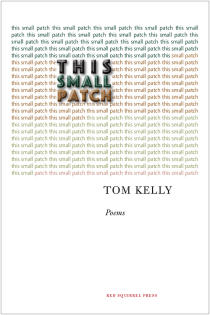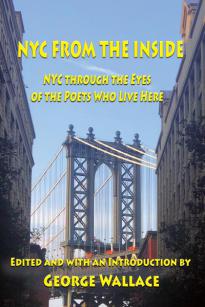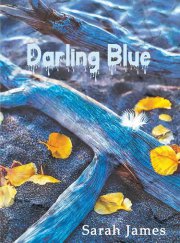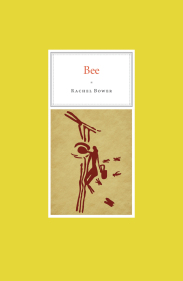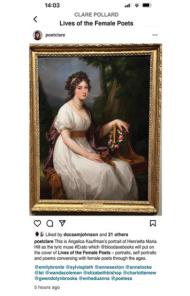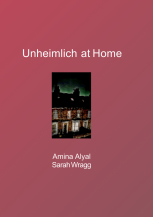
Tom Kelly, This Small Patch,
Red Squirrel Press, 2020.
ISBN: 978-1-910437-91-9.
76pp. £10.00.
I think it can be legitimately claimed that Red Squirrel Press has a distinctive brand, one which reveals consistent editorial choices. The preference is for writing that sidesteps ostentation, indeed favours a plain style and is solidly accessible and lucid. Tom Kelly fits the brief exactly and it is no surprise to discover that this is his eighth collection from Red Squirrel.
This Small Patch does not deviate from what one might have expected from him and the press. The general tone is often redolent of the charmingly flat delivery to be found in TS Eliot’s The Boston Evening Transcript (one of my favourite poems by Eliot) or that of John Ashbery’s The Instruction Manual. To maintain such a style, lines in Kelly that might be deemed ‘poetic’ are resolutely tethered to the quotidian.
Indeed, it is rare for Kelly to embrace lyricism for its own sake. Even when he does, it rarely lifts from everyday discourse. Deluge At The Angel of the North is the sole exception to this, perhaps because it employs rhymed couplets (though it is not the only example of fixed form; two sonnets are included as well). Kelly skilfully balances tonal aspects to preserve a syntax that avoids becoming stilted:
The air is stifling; heaven is near and soft breath love
is whispered to someone, somewhere, their hearts rise above
the sky and refuse what the day will bring as rain broods
then clatters on the car’s roof in this sudden deluge.
That last assonant rhyme has a curve ball effect, twisting expectations with an impact that feels more improvisational and inventive like regular swing music veering into bebop jazz. The choice of “deluge” also provides structural symmetry by repeating the first word of the title with the last word of the poem.
The bulk of This Small Patch (it comprises four-fifths of the book) is a sequence entitled Gyrwe, which is the putative Anglo-Saxon name for Jarrow. Kelly explores through poems and songs the social history of Jarrow, including aspects of his own family history. The overriding association Jarrow will have for most people is the Jarrow Crusade of 1936, a time of great deprivation. As is invariably the case, it was the poorest members of the population who bore the brunt of the deflation that began with the stock market crash of 1929 and came to be known as The Great Depression. Kelly describes the march in his preface: “200 men from the town walked three hundred miles to London to inform the government of the town’s plight.” It is fitting that Kelly focuses primarily on this event, using primary source material and the recollections of family members who took part. Kelly is wise to let this material speak for itself. No amount of poetic rhetoric could equal, for instance, the statements of David Riley, one of the March leaders, which are given verbatim:
In Jarrow after fifteen years of unemployment, people are collapsing from starvation and semi-starvation. We want the right to work: we do not ask for charity. Something must be done, and we shall not stop until something is done.
All the pieces in Gwyre are presented as discrete elements in a sequence, operating more as a montage than a continuous long poem, although the time line followed is roughly chronological. What we have here might be the basis of a film or audio script, or a multi media exhibition, which would add to the impact of Gwyre even more. The songs too could then be included fully realised. As it is, reading them on the page is inevitably an incomplete experience without being able to hear the musical settings. Unlike songs that began as poems and were set to music, pure song lyrics never sit quite right on the page. This is particularly so in the case of the songs in Gwyre where refrains and individual lines are repeated frequently, often within the same song. It might have been an idea to cut back in this respect rather than print the whole song as it is sung.
The smaller section of This Small Patch, just ten poems, is entitled, rather awkwardly it has to be said, Blaydon from Old Norse, The Blar (Cold) Hill. Like Gwyre the starting point is a particular location, but the focus is again human and social rather than topographical. The poems do not constitute a sequence but themes of change, memory and dreams recur. The decline of working men’s clubs (the gender specific designation was of course customary in the heyday of such clubs) features in three of the poems. The final poem, Sometimes it’s like a dream, resonates as a fitting coda to the whole collection:
Uncanny uncertainty, discovering where you are,
day, month, what you have to do.
Past and present fall
between the gaps.
David Mark Williams
To order this book click here
David Mark Williams writes poetry and short fiction. He has two collections of poetry published: The Odd Sock Exchange (Cinnamon, 2015) and Papaya Fantasia (Hedgehog, 2018). For more information go to www.davidmarkwilliams.co.uk
NYC From the Inside ed. George Wallace,
Blue Light Press, 2022.
ISBN: 978-1-4218-3717-8.
250pp. $20.00.
The most fabled city in America is without a doubt New York. Chicago is the City of the Big Shoulders, on Lake Michigan, San Francisco the romantic city by the sea, Los Angeles the modern megalopolis where movies are made. Even Boston calls itself the Hub of the Universe. But none of them excites the imagination the way New York City does.
From Kim Addonizio’s memory of living in Alphabet City, “Blues on Avenue C,” to Carl Watson’s reflections of Harlem in “125th Street,” this anthology covers the length and breadth of New York City. Alphabetically, 177 poets from Grisel Y Acosta to Steve Zeitlin show us New York, from the inside. As Max Blagg writes in “Second Avenue,” channeling Tony Curtis in Sweet Smell of Success, “like Sydney Falco ‘I love this stinkin’ town’ / New York the everturning wheel / that grinds exceeding fine.”
Like any anthology focused on a loose topic, the poems are diverse, though some themes recur. The subway as a place and as a means for getting to other places, public transportation, is familiar in these pages. There’s Steward Florsheim’s “Elevator Down to the ‘A’ Train”; Patricia Spears Jones’ “Mermaid Parade Poem/June 21, 2014 (“Three goddesses on the F train wear red lipstick and carry cell phones…”); Tongo Eisen-Martin’s “New York Because I Said So” (“The 5 train has pillow cases throughout its Franklin Ave. station”); Diane Frank’s “Venantius” (“He was the crazy man / singing the blues between cars / on the A Train”); Kofi Fosu Forson’s “New York Is a Punk Rocker,” which involves the Port Authority bus terminal; Obsidian’s “Train Away” (“I was on the D / Heading south / Out of the Boogie Down”); Thaddeus Rutkowski’s “In the Tunnel,” a poem to an engineer who “makes the trains run on schedule”; Julio Marzan’s “Subway Stairs at Spring Street”; Bob Quatrone’s “On the Money Train”; Francine Witte’s prose poem, “The Moon Takes the E Train”; JP DiBlasi’s “The N Train”; Andy Clausen’s “On the 7”; Steve Dalachinsky’s “Subway Systems”; Carlos Aguasaco’s “From the Center of the Subway Car,” an elegy for a homeless schizophrenic, one of “the subway drifters” who inhabit the underground.
Bill Zavatsky’s charming “104 Bus Uptown” captures the full exuberance of the commute. The poem begins:
How bad can it be
dear wacky New York City,
when the first twelve lines
of The Love Song of J. Alfred Prufrock
blink down at me
from a poster on this bus
brought to us
courtesy of the MTA
and the Poetry Society of America
(of which I am a member!)
The Covid-19 pandemic likewise figures into a number of the poems. Ed Hirsch’s “Eight People” begins grimly:
Eight people died
on my block in Brooklyn
last week
and I didn’t know
what it meant
to be living
at one remove
from each other,
wary,
isolated,
locked up
with the relentless
bad news
Andrei Codrescu’s darkly humorous poem, “The City,” begins with an almost surrealistic dream vision:
in august 2020 birds got fat
they started turning back into dinosaurs
they didn’t miss people
rats on the other hand missed restaurants
the better ones reviewed in the times
there are so many rat snobs
in the infernal month of august 2020
Valery Oisteanu’s “Assisted Revolution” is a poem about Central Park during the pandemic. Ron Kolm’s “A Life Lived in New York City Bookstores” likewise alludes to the pandemic, as does Puma Perl’s “LES: Past and pandemic.”
There are odes to the five boroughs — Queens (Claudine Nash’s “We Used to Call Manhattan ‘The City’ as if Queens Didn’t Count”; Melissa Castillo’s “The Lovers of the Poor”; David Elsasser’s ironic memory of the 1964 World’s Fair “Back to Futurama”); Staten Island (Thomas Fucaloro’s “(I Am Singing Everything Staten Island)”; Pierre Joris’s “Shipping Out of New York Harbor at 1:25 P.M. on HermanMelville’s 200th Birthday, i.e., August 1st 2019”; Angelo Verga’s “Misplaced,” which is sort of an elegy toThe Cornelia Street Café, in Manhattan, where he was longtime literary curator, also alludes to Staten Island); the Bronx (Urayoan Noel’s “Concourse Discourse (off course)”; Vincent Toro’s lovely “It’s November in the South Bronx, and Endless Love” (“is swooping into the apartment windows like an omniscient narrator” ); Manhattan, of course, notably Robert Bly’s “Winter Afternoon in Greenwich Village,” Linda Lerner’s “Times Square: the Crossroads,” and Meg Pokrass’s ode to the theater district, “Before the Audition: Times Square 1990.”; Jennifer Juneau’s “A Kind of Love Story” kind if takes place in Manhattan. Brooklyn gets special attention (Stuart Radowitz’s “Brooklyn”; Nicole Santalucia’s “The Canoli Machine at the Brooklyn Detention Center”; D Nurkse’s “Letter from Brooklyn”; Heeyen Park’s “Bushwick Brooklyn”; Michael Puzzo’s “Almost Brooklyn.” Tony Gloeggler’s “Mid Life Poetry Crises” begins: “Sometimes I get sick / of seeing myself / in my poems, my Brooklyn / accent slurring its way / through every line…”).
Sean Singer’s poem “Schism,” from the perspective of a cab driver, takes a look at a Brooklyn neighborhood
Some people think of Williamsburg as the “hipster apocalypse” and others, the
Orthodox, know the Lord is there with them. She’s pushing a shopping cart full of plastic bottles rescued from trash cans.
There are poems to and about various New York landmarks. Edward Field’s “The Statue of Liberty” regards “beacon of liberty” as a tarnished symbol, as does Karen Finnyfrock’s “The Newer Colossus.” David Lehman’s “The World Trade Center” begins:
I never liked the World Trade Center.
When it went up I talked it down
as did many other New Yorkers.
The twin towers were ugly monoliths
that lacked the details the ornament the character
of the Empire State Building and especially
the Chrysler Building, everyone’s favorite,
with its scalloped top, so noble.
Other poems allude to the World trade Center attack on September 1, 2001, including Don Yorty’s “221,” Charles Rammelkamp’s “Ode to the Orange Bear,” William Heyen’s “Magnets,” and Tony Gloeggler’s already mentioned “Mid Life Poetry Crises.”
So many other first-class poets are included in the line-up, from Denise Duhamel and Cornelius Eady to Martin Espada and Yusef Komunyakaa. Diane di Prima and Lawrence Ferlinghetti, both of whom died in 2020, are also included.
NYC From the Inside is a delightful tour of the legendary metropolis. On the other hand, you must take to heart Frank Murphy’s skeptical poem, “When Our Ancestors Ate Each Other, and They Did” when he writes:
The tour bus is full today, rolling down 7th Avenue
In sunlight so strong it makes one suspicious of everything.
The poem concludes:
Listen, the tour guide is explaining everything
And he’s got it all wrong.
Seriously, though, this anthology is a tour well worth the price of admission.
Charles Rammelkamp
To order this book click here
Charles Rammelkamp is Prose Editor for BrickHouse Books in Baltimore, where he lives, and edits The Potomac, an online literary journal. http://thepotomacjournal.com. His photographs, poetry and fiction have appeared in many literary journals. His latest book is a collection of poems called Mata Hari: Eye of the Day (Apprentice House, Loyola University), and another poetry collection, American Zeitgeist, is forthcoming from Apprentice House.
